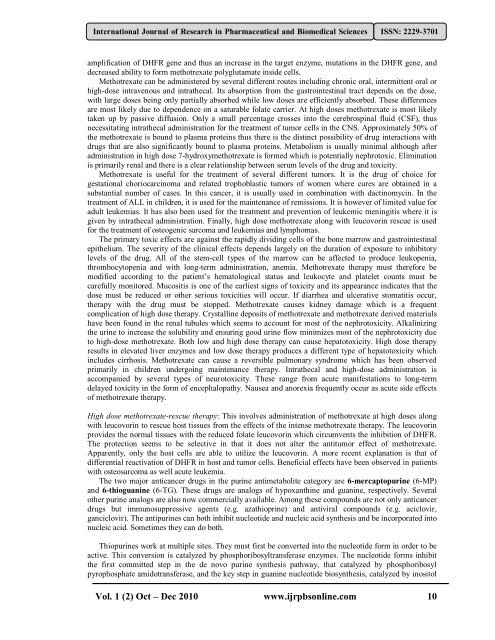Monitoring of Suspected Adverse Drug Reactions in Oncology Unit ...
Monitoring of Suspected Adverse Drug Reactions in Oncology Unit ...
Monitoring of Suspected Adverse Drug Reactions in Oncology Unit ...
Create successful ePaper yourself
Turn your PDF publications into a flip-book with our unique Google optimized e-Paper software.
International Journal <strong>of</strong> Research <strong>in</strong> Pharmaceutical and Biomedical Sciences ISSN: 2229-3701<br />
amplification <strong>of</strong> DHFR gene and thus an <strong>in</strong>crease <strong>in</strong> the target enzyme, mutations <strong>in</strong> the DHFR gene, and<br />
decreased ability to form methotrexate polyglutamate <strong>in</strong>side cells.<br />
Methotrexate can be adm<strong>in</strong>istered by several different routes <strong>in</strong>clud<strong>in</strong>g chronic oral, <strong>in</strong>termittent oral or<br />
high-dose <strong>in</strong>travenous and <strong>in</strong>trathecal. Its absorption from the gastro<strong>in</strong>test<strong>in</strong>al tract depends on the dose,<br />
with large doses be<strong>in</strong>g only partially absorbed while low doses are efficiently absorbed. These differences<br />
are most likely due to dependence on a saturable folate carrier. At high doses methotrexate is most likely<br />
taken up by passive diffusion. Only a small percentage crosses <strong>in</strong>to the cerebrosp<strong>in</strong>al fluid (CSF), thus<br />
necessitat<strong>in</strong>g <strong>in</strong>trathecal adm<strong>in</strong>istration for the treatment <strong>of</strong> tumor cells <strong>in</strong> the CNS. Approximately 50% <strong>of</strong><br />
the methotrexate is bound to plasma prote<strong>in</strong>s thus there is the dist<strong>in</strong>ct possibility <strong>of</strong> drug <strong>in</strong>teractions with<br />
drugs that are also significantly bound to plasma prote<strong>in</strong>s. Metabolism is usually m<strong>in</strong>imal although after<br />
adm<strong>in</strong>istration <strong>in</strong> high dose 7-hydroxymethotrexate is formed which is potentially nephrotoxic. Elim<strong>in</strong>ation<br />
is primarily renal and there is a clear relationship between serum levels <strong>of</strong> the drug and toxicity.<br />
Methotrexate is useful for the treatment <strong>of</strong> several different tumors. It is the drug <strong>of</strong> choice for<br />
gestational choriocarc<strong>in</strong>oma and related trophoblastic tumors <strong>of</strong> women where cures are obta<strong>in</strong>ed <strong>in</strong> a<br />
substantial number <strong>of</strong> cases. In this cancer, it is usually used <strong>in</strong> comb<strong>in</strong>ation with dact<strong>in</strong>omyc<strong>in</strong>. In the<br />
treatment <strong>of</strong> ALL <strong>in</strong> children, it is used for the ma<strong>in</strong>tenance <strong>of</strong> remissions. It is however <strong>of</strong> limited value for<br />
adult leukemias. It has also been used for the treatment and prevention <strong>of</strong> leukemic men<strong>in</strong>gitis where it is<br />
given by <strong>in</strong>trathecal adm<strong>in</strong>istration. F<strong>in</strong>ally, high dose methotrexate along with leucovor<strong>in</strong> rescue is used<br />
for the treatment <strong>of</strong> osteogenic sarcoma and leukemias and lymphomas.<br />
The primary toxic effects are aga<strong>in</strong>st the rapidly divid<strong>in</strong>g cells <strong>of</strong> the bone marrow and gastro<strong>in</strong>test<strong>in</strong>al<br />
epithelium. The severity <strong>of</strong> the cl<strong>in</strong>ical effects depends largely on the duration <strong>of</strong> exposure to <strong>in</strong>hibitory<br />
levels <strong>of</strong> the drug. All <strong>of</strong> the stem-cell types <strong>of</strong> the marrow can be affected to produce leukopenia,<br />
thrombocytopenia and with long-term adm<strong>in</strong>istration, anemia. Methotrexate therapy must therefore be<br />
modified accord<strong>in</strong>g to the patient’s hematological status and leukocyte and platelet counts must be<br />
carefully monitored. Mucositis is one <strong>of</strong> the earliest signs <strong>of</strong> toxicity and its appearance <strong>in</strong>dicates that the<br />
dose must be reduced or other serious toxicities will occur. If diarrhea and ulcerative stomatitis occur,<br />
therapy with the drug must be stopped. Methotrexate causes kidney damage which is a frequent<br />
complication <strong>of</strong> high dose therapy. Crystall<strong>in</strong>e deposits <strong>of</strong> methotrexate and methotrexate derived materials<br />
have been found <strong>in</strong> the renal tubules which seems to account for most <strong>of</strong> the nephrotoxicity. Alkal<strong>in</strong>iz<strong>in</strong>g<br />
the ur<strong>in</strong>e to <strong>in</strong>crease the solubility and ensur<strong>in</strong>g good ur<strong>in</strong>e flow m<strong>in</strong>imizes most <strong>of</strong> the nephrotoxicity due<br />
to high-dose methotrexate. Both low and high dose therapy can cause hepatotoxicity. High dose therapy<br />
results <strong>in</strong> elevated liver enzymes and low dose therapy produces a different type <strong>of</strong> hepatotoxicity which<br />
<strong>in</strong>cludes cirrhosis. Methotrexate can cause a reversible pulmonary syndrome which has been observed<br />
primarily <strong>in</strong> children undergo<strong>in</strong>g ma<strong>in</strong>tenance therapy. Intrathecal and high-dose adm<strong>in</strong>istration is<br />
accompanied by several types <strong>of</strong> neurotoxicity. These range from acute manifestations to long-term<br />
delayed toxicity <strong>in</strong> the form <strong>of</strong> encephalopathy. Nausea and anorexia frequently occur as acute side effects<br />
<strong>of</strong> methotrexate therapy.<br />
High dose methotrexate-rescue therapy: This <strong>in</strong>volves adm<strong>in</strong>istration <strong>of</strong> methotrexate at high doses along<br />
with leucovor<strong>in</strong> to rescue host tissues from the effects <strong>of</strong> the <strong>in</strong>tense methotrexate therapy. The leucovor<strong>in</strong><br />
provides the normal tissues with the reduced folate leucovor<strong>in</strong> which circumvents the <strong>in</strong>hibition <strong>of</strong> DHFR.<br />
The protection seems to be selective <strong>in</strong> that it does not alter the antitumor effect <strong>of</strong> methotrexate.<br />
Apparently, only the host cells are able to utilize the leucovor<strong>in</strong>. A more recent explanation is that <strong>of</strong><br />
differential reactivation <strong>of</strong> DHFR <strong>in</strong> host and tumor cells. Beneficial effects have been observed <strong>in</strong> patients<br />
with osteosarcoma as well acute leukemia.<br />
The two major anticancer drugs <strong>in</strong> the pur<strong>in</strong>e antimetabolite category are 6-mercaptopur<strong>in</strong>e (6-MP)<br />
and 6-thioguan<strong>in</strong>e (6-TG). These drugs are analogs <strong>of</strong> hypoxanth<strong>in</strong>e and guan<strong>in</strong>e, respectively. Several<br />
other pur<strong>in</strong>e analogs are also now commercially available. Among these compounds are not only anticancer<br />
drugs but immunosuppressive agents (e.g. azathiopr<strong>in</strong>e) and antiviral compounds (e.g. aciclovir,<br />
ganciclovir). The antipur<strong>in</strong>es can both <strong>in</strong>hibit nucleotide and nucleic acid synthesis and be <strong>in</strong>corporated <strong>in</strong>to<br />
nucleic acid. Sometimes they can do both.<br />
Thiopur<strong>in</strong>es work at multiple sites. They must first be converted <strong>in</strong>to the nucleotide form <strong>in</strong> order to be<br />
active. This conversion is catalyzed by phosphoribosyltransferase enzymes. The nucleotide forms <strong>in</strong>hibit<br />
the first committed step <strong>in</strong> the de novo pur<strong>in</strong>e synthesis pathway, that catalyzed by phosphoribosyl<br />
pyrophosphate amidotransferase, and the key step <strong>in</strong> guan<strong>in</strong>e nucleotide biosynthesis, catalyzed by <strong>in</strong>ositol<br />
Vol. 1 (2) Oct – Dec 2010 www.ijrpbsonl<strong>in</strong>e.com 10

















